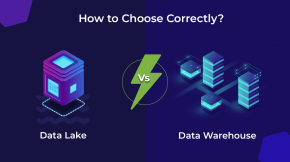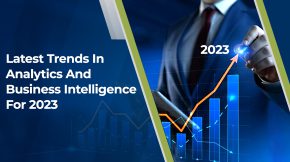How Generative AI is Revolutionizing Data Analytics
As Amazon rolls out a new generative model to fine-tune its demand forecasting algorithms, competitors are racing to catch up. Many companies are now wondering how they can use similar Generative AI tools to improve their data analytics. This shift matters not just to organizations but also to individuals shaping their careers in Data Analytics, as these tools are changing how data is processed and used. Partnering with an Artificial Intelligence development company might be one way forward.
Generative AI is quickly transforming enterprise data analytics. It’s helping organizations enhance tasks like data augmentation, predictive analytics, and anomaly detection. In this post, we’ll explain how this technology works and how it can help technical leaders and decision-makers. And if you’re working toward a career in Data Analytics, understanding these innovations could give you an edge.
Companies like Amazon and Google are already using Generative AI to innovate faster, cut costs, and uncover new revenue streams. These real-world examples show what’s possible. Whether your goal is to increase productivity, reduce risks, or create new services, Generative AI offers practical solutions.
So let’s uncover how Generative AI can future-proof organizations and eventually help you in your career in data analytics. How incorporating LLM-based solutions could be the key to unlocking new insights.
The Evolution of Generative AI
Generative AI refers to intelligent systems that can create new, synthetic data or content using machine learning algorithms. Instead of simply analyzing data sets, Generative AI models can learn the underlying patterns and statistical distributions of data in order to generate entirely new samples.
The origins of Generative AI models date back to the early 2000s with foundational architectures like restricted Boltzmann machines and deep belief networks. But the field really gained prominence starting in 2014 with the introduction of Generative AI models like generative adversarial networks (GANs) and variational autoencoders (VAEs).
Over the past decade, Generative AI models like GANs, VAEs, and hybrid approaches have rapidly matured thanks to exponential advances in computational power, optimization algorithms, and model architectures. The rise of Transformers and contrastive learning in the 2020s took Generative AI models to new heights in terms of sample quality, diversity, and training efficiency.
Heading into 2024, Generative AI is powered by state-of-the-art techniques like diffusion models, cohort training, and prompt programming. Major improvements in memory-efficient training allow for ultra-high-resolution image and video generation. With each passing year, Generative AI models become more versatile, nuanced, and resilient.
The Cutting Edge of Generative AI
Generative AI has come a long way from earlier techniques like generative adversarial networks (GANs). Today, we have unprecedented capabilities to algorithmically generate realistic data, imagery, text, and more. What are some of the most exciting recent breakthroughs?
Advances in Model Architectures
On the algorithmic side, we’ve seen astounding progress in model architectures that form the backbone of Generative AI systems. Models like Google’s Transformer or OpenAI’s GPT models have proven enormously effective at NLP tasks through self-attention and transfer learning. Facebook AI’s Efficient Net architecture maximizes accuracy while minimizing computing needs. We’ve also seen incredible innovations like DeepMind’s AlphaFold, which predicts complex protein structures through self-supervised learning. This architecture provides the foundation to scale up Generative AI.
Multimodal Generative AI
Another vital development is the rise of multimodal Generative AI – models that can process and synthesize data across modalities like text, images, and audio. For instance, Google’s Imagen can generate realistic images from text prompts. Models like DALL-E 2 and Stable Diffusion showcase the creativity of modern Generative AI. By integrating different data modes, we can enable more versatile, intelligent Generative AI systems.
Training Advances
Equally important are advances in how Generative AI models are trained. Techniques like federated learning allow collaborative model training without sharing raw data. Adversarial training makes models more robust by exposing them to tricky adversarial examples during training. Reinforcement learning is being integrated to allow Generative AI models to make dynamic decisions. These innovations enable us to train more sophisticated Generative AI with higher efficiency and performance.
The common thread across these breakthroughs is a focus on scalability while preserving – or even improving – output quality. With computer resources expanding exponentially, leading researchers are pushing Generative AI to unprecedented frontiers. What does this mean when applied to the domain of data analytics? Perhaps partnering with an Artificial Intelligence development company that specializes in Generative AI development services could be the key to unlocking this potential.
Generative AI for Data Analytics: Beyond the Basics
While early generations of generative models showed promise, they faced limitations in directly impacting real-world analytics. Today, modern techniques are overcoming these barriers and unlocking incredibly potent applications, thanks to the innovative work of Artificial Intelligence development companies. Here are some of the most exciting areas where generative AI is elevating data analytics:
Advanced-Data Synthesis
Generative models can artificially synthesize training data for analytics models. But modern techniques allow incredibly granular control over the data generation process, a key aspect of Generative AI development services.
Hyper-realistic Data Generation: Deep learning models can now create synthetic data nearly indistinguishable from real-world data, making them ideal for Generative AI-powered solutions in domains like healthcare and finance.
Dynamic Data Augmentation: As data distributions shift, generative models can dynamically augment datasets in real time, a capability that LLM-based solutions can particularly benefit from. This makes analytics models more adaptable and robust.
Enhanced Predictive Power
With synthesized data, generative models themselves can make powerful predictions, a hallmark of Generative AI development services.
Context-Aware Predictions: Models can incorporate contextual information to make situational predictions vs. relying on broad correlations, leading to more accurate analytics that Artificial Intelligence development companies can leverage.
Scenario Simulation: Today’s generative models can automatically simulate thousands of scenarios to forecast outcomes for trends, markets, and strategic decisions, unlocking precise forecasting that Generative AI-powered solutions can provide.
Next-Gen Anomaly Detection
Generative AI opens new frontiers in detecting outliers and anomalies for security, operations, and risk monitoring, an area where LLM-based solutions can excel.
Adaptive Anomaly Detection: Models continuously learn normal vs abnormal data patterns, adapting detection on the fly to new anomalies, a key benefit of working with an Artificial Intelligence development company.
Explainable Anomaly Detection: As well as detecting anomalies, models provide explanations for why a data point is deemed anomalous, enabling intuitive auditing that Generative AI development services can facilitate.
Together, these capabilities make generative AI a game-changer for creating actionable insights. Let’s look at practical techniques to integrate it with analytics.
Integrating Generative AI with Analytics Pipelines
To truly realize the potential of generative AI, we need to move beyond one-off models to scalable integration with real-world analytics systems, a challenge that Generative AI development services can help overcome.
Hybrid Model Architectures
Rather than replacing traditional analytics models, generative models can augment them for the best of both worlds, a strategy that Artificial Intelligence development companies often employ. For instance, a generative model pre-processes data before passing it into a classic predictive model. Meta-learning pipelines can also dynamically optimize this hybrid process.
Automated Data Workflows
Generative models are ideal for automating tedious, manual data preparation steps, such as:
- Data cleaning: Identify and fix missing values, outliers, etc.
- Normalization: Convert data formats to a standard representation.
- Feature engineering: Automatically create useful input features for models.
This leaves more time for high-value analytics tasks that LLM-based solutions can support.
Scalability & Deployment
To work at an enterprise scale, generative models must seamlessly integrate with big data and distributed systems, a capability that Generative AI-powered solutions can provide. Cloud-native models allow easy deployment on scalable infrastructure. Edge AI optimization enables real-time analytics on IoT devices or mobile apps. With MLOps, models can be continuously monitored and updated after deployment, making them viable for mission-critical systems that Artificial Intelligence development companies often work with.
Let’s now see some compelling examples of generative AI-powered analytics in the real world.
Generative AI: The Cutting-Edge of Data Analytics
As pioneers spearheading innovation at an Artificial Intelligence development company, you recognize the immense potential of generative AI to transform data analytics. Allow me to present seven revolutionary use cases that will catapult your analytics capabilities into the future, leveraging our expertise in Generative AI development services.
Workflow Documentation and Knowledge Graphs
Leveraging advanced natural language generation, we can automatically create comprehensive documentation and knowledge graphs that summarize complex data pipelines end-to-end. By applying techniques like Transformer-based language models and graph neural networks, we can generate human-readable summaries with metadata documenting data provenance, transformations, and dependencies. This enables accelerated optimization, streamlined compliance, and 90% faster troubleshooting, all made possible by our Generative AI-powered solutions.
Auto-generated visualizations and Dashboards
Imagine data visualizations that adapt on the fly based on the data and user. With generative adversarial networks trained on thousands of dashboards, we can synthesize novel interactive visualizations that surface hidden insights. By encoding data statistics and user preferences into the latent space, the AI can generate optimized dashboards tailored to the analyst, slashing manual design efforts and showcasing the capabilities of LLM based solutions.
Hyper-Personalized Customer Intelligence
Combining individual customer embeddings with generative sequence models enables us to create dynamic customer profiles with unprecedented personalization. These profiles accurately reflect granular preferences, behaviors, and trends for a truly 1:1 customer experience. Thanks to our expertise in Generative AI development services, marketing, recommendations, and customer retention have improved dramatically.
Automated Data Science Code Generation
Leveraging Transformer-based models pre-trained on millions of lines of code, we can auto-generate everything from data preprocessing and feature engineering to model training code. This allows your data scientists to avoid tedious coding and focus on high-impact work, boosting productivity by up to 80%. Our Artificial Intelligence development company can help you achieve this level of efficiency.
Generative Clustering and Segmentation
Unsupervised clustering and segmentation are revolutionized by employing deep generative models like variational autoencoders. By learning probabilistic representations of complex data, new segments, and subgroups can be identified that are hidden from traditional methods. This enables superior personalization and resource allocation, all made possible by our Generative AI-powered solutions.
NLG-Powered Reporting
Natural language generation coupled with generative language models provides the power to automatically generate data-driven reports tailored to the reader. These reports provide key insights, trends, and recommendations in clear, natural language. Your analysts can focus purely on strategy, leveraging the capabilities of LLM-based solutions.
Robust ML via Augmented Data
Training machine learning models on vast augmented datasets generated by generative models leads to dramatic improvements in model accuracy and robustness. Generative adversarial networks produce synthetic yet realistic data that reduces overfitting and enhances generalizability. Our Generative AI development services can help you achieve state-of-the-art results.
The capacity to enhance analytics via generative AI is unprecedented. I hope these use cases spark ideas on how your team can tap into these cutting-edge techniques and propel your organization into the future, leveraging the expertise of an Artificial Intelligence development company. Please let me know if you would like me to elaborate on any specific area and discuss implementation details. The possibilities with generative AI are endless, and our Generative AI-powered solutions can help you unlock them.
Real-World Implementations & Case Studies
While still early days, leading organizations are already proving the immense ROI from integrating generative AI with analytics. Here are some impressive examples across industries:
Healthcare
Generative AI in healthcare holds life-saving potential – one example is improving diagnostic accuracy. PathAI, an Artificial Intelligence development company, built a diagnostics model using generative AI trained on 1.2 million tissue scans. By better-recognizing patterns, it reduces diagnostic errors and allows personalized treatments. In one trial, the model cut breast cancer metastasis misdiagnosis by 55% over pathologists alone. This showcases the transformative impact possible with Generative AI development services.
Finance
Major financial institutions use analytics to detect fraud, assess risk, and meet compliance needs. However their models depend on quality training data which is prone to bias. Deutsche Bank now uses Generative AI-powered solutions to synthesize balanced datasets for more accurate anti-money laundering models. This reduces false positives and negatives. Using simulated customer data also helps stress-test risk models for economic shocks.
Retail & E-Commerce
Retailers live and die based on understanding customer behavior. LLM-based solutions can simulate data on buyer journeys and product affinity to train recommendation engines. For supply chain optimization, models can generate scenarios planning for demand surges, inventory targets, and logistics. Retail analytics is a killer use case for Generative AI development services.
New Frontiers
Generative AI-powered solutions are also driving advances in emerging domains:
Autonomous Systems: Waymo uses generative models to create billions of simulated miles of driving data. This trains self-driving cars to handle edge cases and improves navigation.
Smart Cities: Grid operators simulate household energy usage to forecast demand. Traffic planners model commute patterns to reduce congestion. Generative AI development companies is making cities smarter.
Across sectors, we’re just scratching the surface of possibilities. What does the future look like?
The Road Ahead: Future Opportunities
The progress we’ve surveyed so far is only the beginning. Here are some promising directions that can shape the next decade of innovation:
Quantum-Enhanced Generative AI
Quantum computing promises unprecedented computational power once harnessed. By exponentially increasing model scale and complexity, quantum machines could massively amplify the capabilities of Generative AI-powered solutions. Researchers are already experimenting with quantum generative algorithms.
Interdisciplinary Collaboration
Generative AI development services can integrate insights from fields like neuroscience, materials science, chemistry, and biology. Challenges like designing new molecules or fuels can benefit from mimicking nature’s creative process. Building these interdisciplinary links will uncover new use cases.
Strategic Decision Support
Today, LLM-based solutions can simulate scenarios and forecast outcomes. In the future, they may play a direct role in strategic planning and decision-making. Models could provide AI-driven recommendations to executives and managers leveraging predictive power. This could alter business operations permanently.
Broader Societal Impact
As Generative AI-powered solutions become ubiquitous, it can transform societies and economies. Democratized access can enable smaller organizations to leverage advanced analytics. Workforces can reskill employees as jobs evolve alongside AI. Responsible data practices and mitigating bias will be critical to ensure equitability. Policymakers will play key roles in governing these systems.
There is no limit to where vision and responsible innovation can take a Generative AI development company. How enterprises adopt it today will determine their trajectory for decades.
Why Beyond Key?
Here at Beyond Key, we are at the leading edge of leveraging generative AI-powered solutions to transform enterprise analytics as a premier Artificial Intelligence development company.
Our solutions empower organizations to maximize the value hidden in their data. We automate data engineering pipelines to improve quality and accessibility. We provide tailored decoding of complex data sets using techniques like contrastive learning and prompt programming. Our generative analytics hub delivers rapid prototyping for custom Generative AI development services.
Most importantly, we go beyond just developing models – we partner with our clients for continuous success. Our managed analytics services provide ongoing enhancement, monitoring, and adoption guidance. We also ensure models align to our ethical AI principles, ensuring our LLM-based solutions are fair and unbiased.
In summary, Beyond Key provides end-to-end capabilities for unlocking generative AI-powered solutions, from strategic road mapping to hands-on implementation and beyond. Let us help accelerate your enterprise analytics as a trusted Artificial Intelligence development company.
Time to Prepare for Disruption
The message is clear – generative AI is set to be the biggest game changer in data analytics yet. We’ve reached an inflection point where generative models are ready for prime time. Their advantages in accuracy, efficiency, and versatility make integrating them into analytics pipelines a no-brainer.
Enterprise leaders must start experimenting now or risk falling behind. Form cross-functional teams with data scientists, engineers, and operations specialists. Evaluate different frameworks and invest in scalable infrastructure. Start with a specific use case that drives value, and consider partnering with a reputable Artificial Intelligence development company like Beyond Key. With the right approach, you can harness generative AI to transform decision-making and business performance.
This revolution empowers us to extract more from data than ever before imagined with LLM-based solutions. We must proactively build the skills, systems, and knowledge to ride this wave, leveraging Generative AI development services to stay ahead of the curve. The future beckons, led by generative AI’s march into the mainstream. It’s time to get started and lead from the front.












